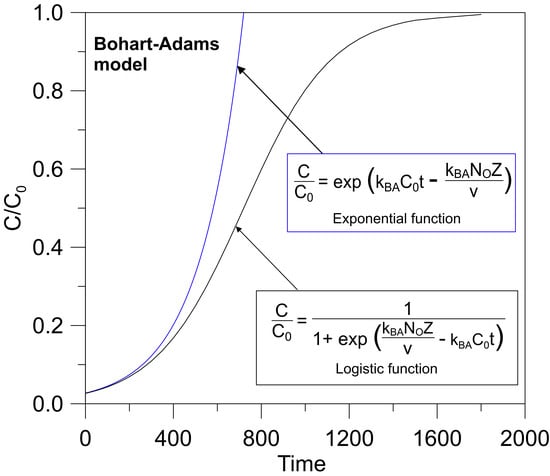Comments on “Dynamic Adsorption of Sulfamethoxazole from Aqueous Solution by Lignite Activated Coke”
Abstract
1. Introduction
2. Discussion
2.1. The Bohart–Adams Model
2.2. The Bohart–Adams, Yoon–Nelson and Thomas Model
Funding
Institutional Review Board Statement
Informed Consent Statement
Data Availability Statement
Conflicts of Interest
References
- Li, H.; He, J.; Chen, K.; Shi, Z.; Li, M.; Guo, P.; Wu, L. Dynamic Adsorption of Sulfamethoxazole from Aqueous Solution by Lignite Activated Coke. Materials 2020, 13, 1785. [Google Scholar] [CrossRef] [PubMed]
- Xu, Z.; Cai, J.G.; Pan, B.C. Mathematically modeling fixed-bed adsorption in aqueous systems. J. Zhejiang Univ. Sci. A 2013, 14, 155–176. [Google Scholar] [CrossRef]
- Chu, K.H. Breakthrough curve analysis by simplistic models of fixed bed adsorption: In defense of the century-old Bohart-Adams model. Chem. Eng. J. 2020, 380, 122513. [Google Scholar] [CrossRef]
- Yan, J.; Xue, Y.; Long, L.; Zeng, Y.; Hu, X. Adsorptive removal of As(V) by crawfish shell biochar: batch and column tests. Environ. Sci. Pollut. Res. 2018, 25, 34674–34683. [Google Scholar] [CrossRef] [PubMed]
- Tan, K.L.; Hameed, B.H. Insight into the adsorption kinetics models for the removal of contaminants from aqueous solutions. J. Taiwan Inst. Chem. Eng. 2017, 74, 25–48. [Google Scholar] [CrossRef]
- Chatterjee, A.; Schiewer, S. Biosorption of Cadmium(II) Ions by Citrus Peels in a Packed Bed Column: Effect of Process Parameters and Comparison of Different Breakthrough Curve Models. CLEAN-Soil Air Water 2011, 39, 874–881. [Google Scholar] [CrossRef]

Publisher’s Note: MDPI stays neutral with regard to jurisdictional claims in published maps and institutional affiliations. |
© 2021 by the author. Licensee MDPI, Basel, Switzerland. This article is an open access article distributed under the terms and conditions of the Creative Commons Attribution (CC BY) license (http://creativecommons.org/licenses/by/4.0/).
Share and Cite
Juela, D.M. Comments on “Dynamic Adsorption of Sulfamethoxazole from Aqueous Solution by Lignite Activated Coke”. Materials 2021, 14, 848. https://doi.org/10.3390/ma14040848
Juela DM. Comments on “Dynamic Adsorption of Sulfamethoxazole from Aqueous Solution by Lignite Activated Coke”. Materials. 2021; 14(4):848. https://doi.org/10.3390/ma14040848
Chicago/Turabian StyleJuela, Diego M. 2021. "Comments on “Dynamic Adsorption of Sulfamethoxazole from Aqueous Solution by Lignite Activated Coke”" Materials 14, no. 4: 848. https://doi.org/10.3390/ma14040848
APA StyleJuela, D. M. (2021). Comments on “Dynamic Adsorption of Sulfamethoxazole from Aqueous Solution by Lignite Activated Coke”. Materials, 14(4), 848. https://doi.org/10.3390/ma14040848






